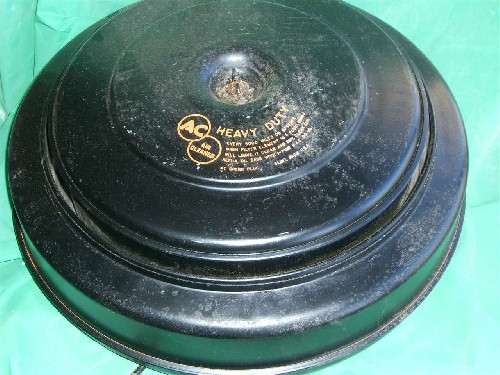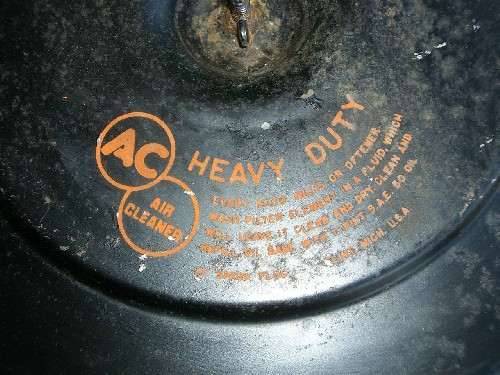|
Re: Engine Bay detailing on a '56 dual carb car
|
||||
|---|---|---|---|---|
|
Forum Ambassador
|
The ign wire brackets were a fairly late changepackardinfo.com/xoops/html/downloads/SC/SC-VOL30NO3.pdf
The hose clamps should be the wire type and there are some vendors selling kits of the correct ones. Some on here have bought them and can point you their direction. Just make sure the hoses you use with them are not the cheaper smaller diameter type sometimes found in parts stores now or the tension might not be sufficient.
Posted on: 2010/10/31 21:39
|
|||
|
||||
|
Re: Engine Bay detailing on a '56 dual carb car
|
||||
|---|---|---|---|---|
|
Home away from home
|
According to the Feb 55 "Finish" magazine article on the new Connor Avenue plant, fenders, hoods, and skirts were all "flow-coated" with black enamel and then baked. Afterwards they were mounted on a finishing conveyor line with the fenders draped in pairs over something akin to sawhorses about a foot apart from each other and canted slightly outward at the bottom. In this position they were sprayed, finish sanded, and buffed before going to assembly. That is why all 55-56 unscrewed with cars have body color on the inner fender portion. It is a natural result of the way they were fixtured for painting. That is also why the paint fades away to black towards the bottom of the air duct as there was no way or desire to spray there. The hoods were laid flat on the same carriage, along with the skirts. That is why the hood and skirts are black on the "off" side, but with plenty of overspray.
No one at Connor had the time or inclination to mask off the inner fenders in any way.
Posted on: 2010/10/31 21:39
|
|||
|
||||
|
Re: Engine Bay detailing on a '56 dual carb car
|
||||
|---|---|---|---|---|
|
Home away from home

|
Yes. My very original 56 Executive has black inner fender wells. Bottom of hood is black too. NO Norweigen Forest overspray either. NO overspray of any type on the black.
Posted on: 2010/10/31 21:55
|
|||
|
VAPOR LOCK demystified: See paragraph SEVEN of PMCC documentaion as listed in post #11 of the following thread:f
packardinfo.com/xoops/html/modules/newbb/viewtopic.php?topic_id=7245 |
||||
|
||||
|
Re: Engine Bay detailing on a '56 dual carb car
|
||||
|---|---|---|---|---|
|
Home away from home
|
These are new old stock out of the box air cleaners
Posted on: 2010/11/1 7:16
|
|||
|
||||
|
Re: Engine Bay detailing on a '56 dual carb car
|
||||
|---|---|---|---|---|
|
Forum Ambassador

|
Ross -
Never heard of that magazine title, but thanks for providing us with some documented insights on Packard's production paint techniques from back in the day. That really helps explain differences between paint treatments of the 55-56 and 51-54 cars. It also helps explain why I've seen black showing through on the top of fenders on badly weathered V8 cars of all colors. I wonder, now, if the use of a black "base coat" extended to other areas of the car. I must admit that my observations of body color on the wheel well were based on the more visible rear portion (with the wheel turned). Here in PA, I've found the rest of the wheel side of the fender and splasher covered with surface rust - unless any undercoating material was still intact. Painted by the factory at that angle, perhaps the wheel side of the fender splasher got a some body colored paint - a reverse of the effect on the engine side. Regardless, I'm glad to learn that black is correct for the wheel side of the fender well. As for not masking off the inner fenders in any way, I suspect that "mind set" had become the norm for most auto makers, by then. That "Finish" magazine article should be included as an eyewitness account in any judging guide. Is it possible to provide a scan to BigKev without infringing on copyright?
Posted on: 2010/11/1 8:59
|
|||
|
||||
|
Re: Engine Bay detailing on a '56 dual carb car
|
||||
|---|---|---|---|---|
|
Forum Ambassador

|
Take a look at the inner front wheel well on this "as delivered" new Carib. Even in shadow I suspect it would be lighter if it was Dover White. Also look at that little spot subject to so much debate between the upper front bumper on the side just below the parking light. There are those who claim this should be the lower body color, and if you follow the trim lines it might appear so. Yet there are other factory photos (in B&W, unfortunately) which seem to show the lower body color. I suspect this paint feature wasn't consistent throughout the production run.
Posted on: 2010/11/1 9:07
|
|||
|
||||
|
Re: Engine Bay detailing on a '56 dual carb car
|
||||
|---|---|---|---|---|
|
Forum Ambassador

|
I have a full set of prints of that car - made from the original color slides, which were taken on delivery day, back in '56.
However, in this part of the country, which typically gets snowfall for 5-6 months out of each year and where salt is used heavily on the roads, it's impossible to tell from such a photo whether the wheel wells on that car were painted black from the factory or were undercoated locally. Until recent years, undercoating/rustproofing was a popular up-sell for new car dealers around these parts. Regardless, I think the information provided by Ross provides a sufficient answer to the question of paint color. WRT to the treatment for the parking light area on front fenders of the 55-56 Caribbeans, I don't believe that the lower body color belongs there. If you inspect the fender of an unrestored '56 Four Hundred or Patrician with two-tone paint and the side trim removed, you'll see why. I found this out when I acquired a pair of '56 front fenders from a western car - bare, but still wearing the original paint. In masking the fender for two-tone paint, the line between the colors, logically, runs underneath the heavy die-cast side molding - that is, until it reaches the end of the top of the wheel opening. From that point, it runs down at angle to the the rear of the center line of the lower side molding. Of course, that angle is covered by the ribbed stainless insert, and the lower body color, naturally then, appears on the parking light area of the two-tone cars. However, they couldn't do that on a tri-tone Carib, where no ribbed trim is used. Now, I've never inspected a set of '55 front fenders in same condition, but only suspect they would have used same approach. IMHO, although the line of the lower rear molding makes it tempting to extend the lower body color forward, that area of the front fender below the parking light on the 55-56 Caribbeans should be the middle color.
Posted on: 2010/11/1 9:18
|
|||
|
||||
|
Re: Engine Bay detailing on a '56 dual carb car
|
||||
|---|---|---|---|---|
|
Forum Ambassador
|
BH wrote
Of course this area is covered by the ribbed stainless insert. The lower body color natually appears on the parking light area of the two-tone cars, but they couldn't do that on a tri-tone Carib, where no ribed trim is used. I'm not quite following your statement that they couldn't do that on a tri tone car because of the ribbing. Logically, since the areas are the same width and there is ribbing and a bottom piece of chrome, to me it would be lower color and no big deal to paint it. We must accept that it is not though and the way Ross describes the procedure, I would suspect it was more they didn't want to bother with the additional masking for that tiny area that was half covered anyway. As to the wheel wells, inner fenders and oversprayed areas, I really wonder if the other luxury cars of the time were that careless.
Posted on: 2010/11/1 9:44
|
|||
|
||||
|
Re: Engine Bay detailing on a '56 dual carb car
|
||||
|---|---|---|---|---|
|
Forum Ambassador

|
HH56 -
Yes, that initial statement was a bit awkward on my part. I was working on editing that when you posted, but let me try to clarify it even further. (I'll then go back and try to edit some earlier posts for clarity.) On two-tone Four Hundreds and Patricians, anything below the masking line gets painted lower body color, including the parking light area. The angled portion of the masking line, aft of the wheel opening, is hidden by the ribbed stainless insert used on those cars. However, because that same area is painted middle color on the 55-56 Caribbeans, the boundary for the upper color is completely straight. Therefore, everything below the masking line for the upper color on Caribbeans got sprayed in the middle color - including the parking light area. On my unrestored H/T, it appears that the factory then masked for the lower color, from the rear of the front wheel opening, and rearward. (In fact, I have found traces of Socttish Heather under the Maltese Gray on my H/T.) The parking light details is a compeltely separate issue from the fender splasher color and Ross' description of factory techinque. As for other so-called luxury cars of the period, they were all mass-produced with haste. I've seen Caddies from the mid- to late-50s with far more problems than I ever saw on any V8 Packard. Yet, the 56-57 Continental Mark II might be the lone, shining exception to run-of-the-mill quality of that time.
Posted on: 2010/11/1 10:09
|
|||
|
||||

 (91.12 KB)
(91.12 KB)













